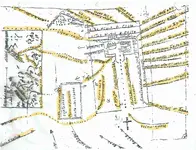Great Research
Great Research.
If you can read Espanol Mejicano, then "Siete Leyendas de Chihuahua" is a good additional confirmation of what you are saying.
Nonetheless, there has been much more than one "Chato" or "El Chato", as far as a name goes.
Counter to that: I have not been able to find any direct non-treasure reference to a 1600's El Chato.
But counter to that, the nice waybill in original period Spanish script in the front of Fowler's quite rare book has just such a reference.
!Quein Sabe!
Lots of lost signs on the ground. Scan those old photos before they are lost forever! That's my mission (not having a time machine!)
Incidentally, I have a waybill for some El Chato caches down South at Pilares, as well.
I suppose that a bandit might get around and cache things here and there. There's also maybe more than one El Chato over the years.
I have probably 20 different hand-written El Chato waybills in various English translations and some original Spanish. Most are either Caballos or Organs.
Caballos have been named as such for a very long time. Older than Pike, as one mentioned, IIRC, but I'm always open to better evidence. David Rumsey's map site may confirm. El Perillo is a name associated with several localities in the SW, as well as a tribe (Apaches Perillos) at one time. Main reference is to Point of Rocks and Agua del Perillo where the cattle mess is now as you go up the Jornada from the Upham exit with the stupid new signs.
The newer El Chato operated out of Babonollaba.
Keep it up!
It's time here to remind folks of some proven facts. Facts are nasty problems when it comes to treasure legends, but what do you prefer to believe - the treasure magazines or your own lyin' eyes?
There are many versions of the famous El Chato gallows confession directing searchers to the Caballo Mountains where he allegedly hid his bandit loot. I don't know when and by whom this waybill was first cooked up, but all of them are fraudulent copies of each other.
The authentic man,
Pedro Navarez ("El Chato"), was was a noted and well-documented bandit active in Chihuahua, Mexico, in the early 1800's, not in the 1600's. Much folklore surrounds his memory as a Robin Hood-type character who cached robbery proceeds all over the Satevo-Parral-Delicias country south of Chihuahua city. Reports of his death are highly romanticized in Mexico, but the waybills to his treasures were apparently disclosed by his daughter in the 1840s and consisted mainly of coins buried in clay pots on several ranches. There is little reason to believe he was ever in New Mexico, where the pickings for roadside bandits were very slim along the Rio Grande, especially compared to the riches available in Chihuahua at the time. Somebody stole El Chato's life story and tried to apply it to New Mexico, where nobody knew the truth. Here, read about him for yourself:
La leyenda siempre viva del Chato Nevárez
El Real de Chihuahua
Suspenso y Terror de Chihuahua There's plenty more you can find on your own - if you care about the truth, that is.
By the way, speaking of facts, the 1650 El Chato waybill directs one to the "Caballo Mountains", north of El Paso on the Rio Grande. But did you know that those mountains were named by Zebulon Pike during the winter of 1806-07? Before that, on an 1804 map, the range was called "Las Peneulas". Before that, in 1771, they were known as "Sierra el Perillo." If someone's going to dream up a good treasure story, it's a good idea for him to check the facts before he starst.
So, Roger, do yourself a favor and lose your El Chato embellishments and stick to Padre LaRue. Oh, by the way, the alleged French priest LaRue is totally absent from the Franciscan records of their operations on the Mexican northern frontier. It's as if such a person never existed. Except in the treasure magazines, that is?




 ??
??


